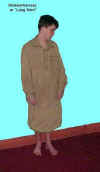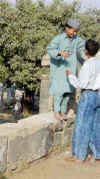By Geoff O'Callaghan
Making Traditional Scout Shirts and Bush Shirts
The Traditional Scout Shirt and How to Make it.
 Lord
Baden Powell was a military officer, and he used his knowledge when developing
his movement, Scouting. Although he did not see scouting as a military movement,
and sometimes went out of his way to ensure that it worked for peace, there were
many military aspects to the form and style of scouting. For instance, the
Patrol was similar to an infantry section. Instead of a corporal and lance
corporal, he called the leaders Patrol Leaders, and Seconders. It should not be
too surprising to find that the early scout uniforms were based on the British
Army uniforms worn by soldiers in the colonies.
Lord
Baden Powell was a military officer, and he used his knowledge when developing
his movement, Scouting. Although he did not see scouting as a military movement,
and sometimes went out of his way to ensure that it worked for peace, there were
many military aspects to the form and style of scouting. For instance, the
Patrol was similar to an infantry section. Instead of a corporal and lance
corporal, he called the leaders Patrol Leaders, and Seconders. It should not be
too surprising to find that the early scout uniforms were based on the British
Army uniforms worn by soldiers in the colonies.
In 1921, BP visited Australia. among the many isolated towns and cities that he saw, the town of Alice Springs was honored to receive him. The son of the local publican was a keen boy scout, and his father was a keen photographer. Lord Baden-Powell issued the scouts of Alice Springs with their scout uniforms. The event was faithfully recorded on film, and is in the collection of the Northern Territory Parliamentary Library. The collection is under severe restriction. It can be viewed, but photographs may not be borrowed or copied. Nevertheless, the uniform details are faithfully recorded for posterity.
The Traditional Scout Shirt Style Given to the Scouts in Australia by B.P.
The boys wore brown leather shoes with knee length socks held up by garters with tabs, Khaki brown shorts with belt loops, leather belts with scout buckles, and Khaki shirts with 2 chest pockets, long sleeves, closed fronts, epaulettes, and attached collars.
The collars were unusual, in that they dropped down to a point at the middle of the back yoke, to which they were buttoned. The scarf was worn over the top of the collar, not under it. Each boy also had the traditional "lemon-squeezer" bashed felt hat. The 2 pockets had scalloped flaps over a centrally ribbed pocket. The pocket buttons were brass with the scout arrow device embossed. They attached to the pocket with a small keeper. The sleeves were rolled up.
This style of shirt is closely associated with the history of Australia. It is in fact, part of our National Folk Costume, although it is seldom worn as such. The Closed Front style is often seen on characters in Australian Films. It is often called a "Bush Shirt". The Australian Army wore them right through WWII.
The Long Shirt
 The
interesting fact is, that this style of shirt has a history spanning more than a
thousand years. It was the style favored by the Prophet Mohammed during his
lifetime. At that time, it was called "The Long Shirt" because it hung
down, almost to the ankles.
The
interesting fact is, that this style of shirt has a history spanning more than a
thousand years. It was the style favored by the Prophet Mohammed during his
lifetime. At that time, it was called "The Long Shirt" because it hung
down, almost to the ankles.
Buttons were used for fastening, and the Mohammedans invented the closed front shirt with the attached collar. The shirts are still widely used in Afghanistan and Pakistan, even today.
How did they become the scout shirt? Well the British invaded India and took it over. They needed shirts for their soldiers. You see, in England, shirts were a sort of under-garment.
A gentleman always wore a waistcoat and overcoat on top of his shirt, but India was so hot, that they had to remove these outer garments. The shirts they had, were loose and blousy things with a front slit closed by tapes. They were most unsuitable for wearing in the tropics.
So the army purchased Afghan style shirts, but in a shorter style that could be tucked into the trousers.
At that time, the cotton industry was just taking off in India, and the new style of shirts were traded all over the world. They were found in Africa, Australia, America, and Europe. They are still around today, as a Workman's shirt, especially as a safety garment for mechanics and machinists in industry.
 Recently,
a new use has been found for the C.Fr. style shirt. It has been found that the
style affords a very high level of protection against Ultra-violet radiation.
especially when made of dark colored, heavyweight, cotton drill fabrics. They
are also cool to wear in the heat, because the C.Fr. design encourages air to
move around the chest and neck - unlike open fronted shirts that allow hot air
to flow around the body. Well, the Mohammedans knew that a thousand years ago.
Recently,
a new use has been found for the C.Fr. style shirt. It has been found that the
style affords a very high level of protection against Ultra-violet radiation.
especially when made of dark colored, heavyweight, cotton drill fabrics. They
are also cool to wear in the heat, because the C.Fr. design encourages air to
move around the chest and neck - unlike open fronted shirts that allow hot air
to flow around the body. Well, the Mohammedans knew that a thousand years ago.

Traditional Scout Shirt shown
here without badges or scarf.
The traditional Scout Shirt, is a variation of The bush shirt, an icon garment
that was common in Australia during the gold rush era. In fact, Baden Powell
designed the scout shirt after the military shirt worn in India and Africa. The
origins of this shirt go back to the Long Shirt (Kameez) worn by Islamic men in
Afghanistan. The Closed Front design was made in India, and traded all over the
world in the 19th century.
Features of the Scout shirt are the long sleeves, collar on stand, epaulettes, 2 breast flap-pockets and the Closed placket front with a unique 'foot' or square stitch design at the base. We should be proud that the Scout Shirt has such a long history. Whenever scouts wear it, they know its origins can be traced back to the shirts brought to Australia and presented to Australian Scouts during Baden-Powell's visit.